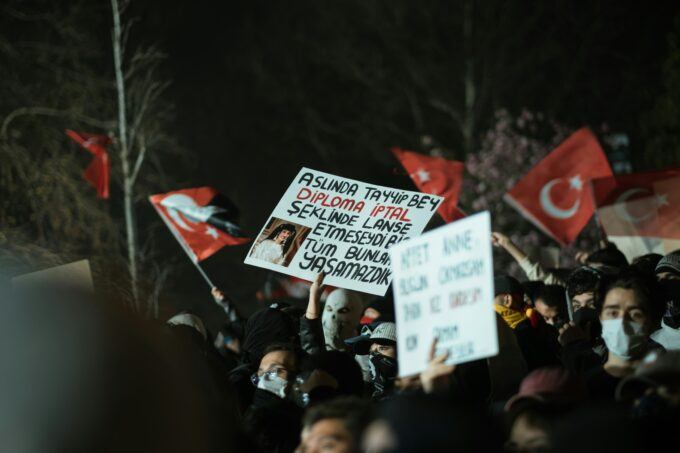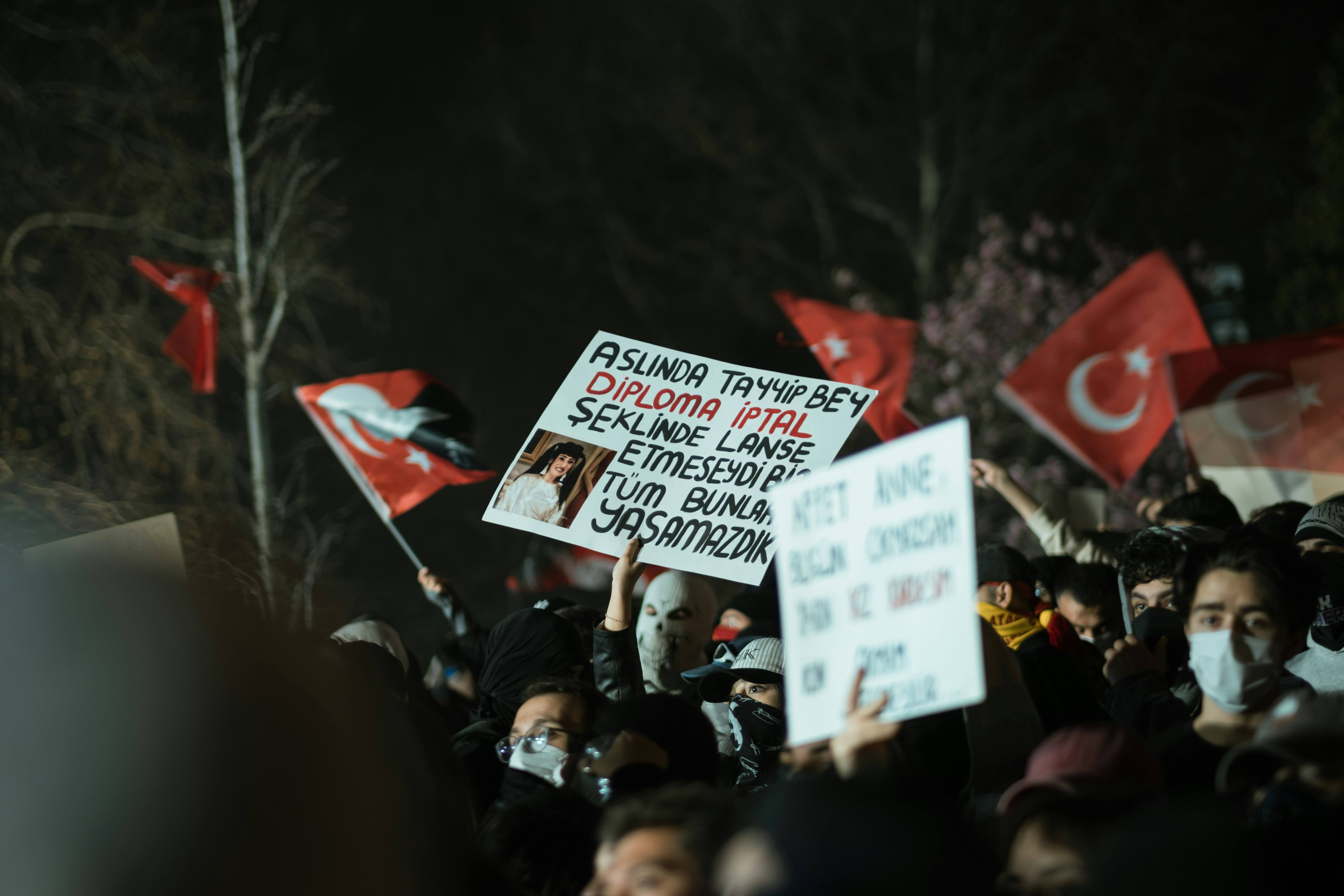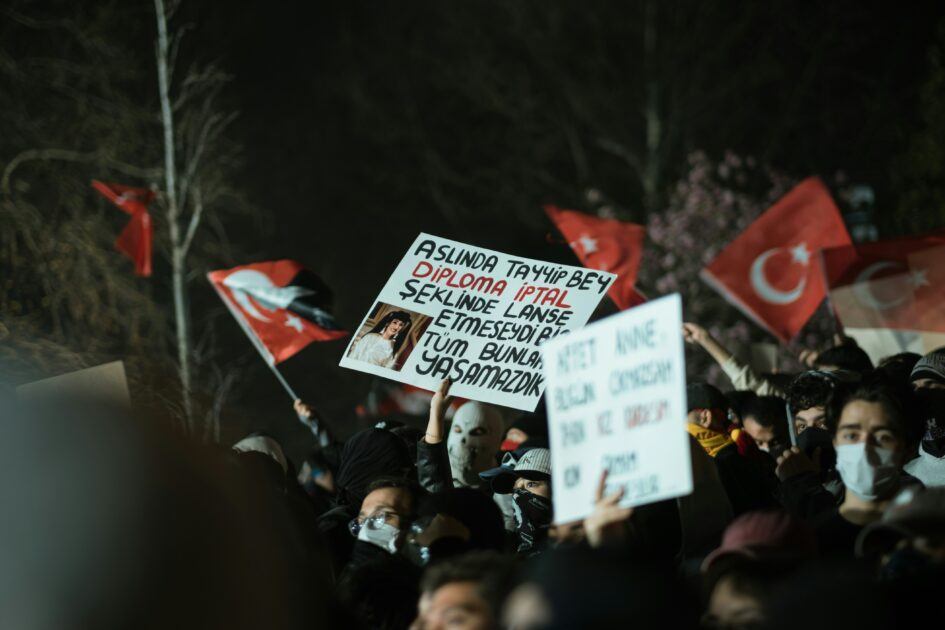






























































Image by Mahmut Yıldız.
The protests that have swept across Turkey in recent weeks were triggered by the jailing of Istanbul’s elected mayor and several members of his municipal team –a move widely perceived as a politically motivated crackdown on democratic opposition. On March 26, 2025, Ekrem İmamoğlu, a politician widely associated with the opposition’s municipal gains since his landmark election victories in 2019, was arrested on what many, including me, consider to be spurious charges aimed at neutralizing a key political rival ahead of upcoming national elections. The detainment of İmamoğlu and his colleagues has not only outraged millions of citizens who voted for them but has also reignited broader frustrations over authoritarianism, judicial overreach, and the systematic erosion of democracy. What began as spontaneous demonstrations in major urban centers quickly evolved into a nationwide wave of protests, uniting diverse segments of society in defense of democratic representation and the rule of law.
Yet instead of capturing the nuance and civic character of this movement, The Guardian Weekly, in its 4 April 2025 edition, published a cover under the sensational headline: “Is This the End of Turkish Democracy?”. Accompanied by a striking image of a protester in a gas mask, arms outstretched in a pose reminiscent of a Sufi whirling dervish, immersed in a cloud of reddish smoke, the cover ostensibly aims to dramatize the crisis in Turkey.[1]* However, what it ends up doing is quite another matter. By invoking orientalist visual codes –spiritual mysticism, exoticized ritual, and performative rage– it aestheticizes unrest, flattens a complex political moment into a consumable spectacle, and recycles essentialist tropes that do more harm than good.
The Burden of Representation
Let us begin with the choice of imagery. The gas mask, the smoke, the arms extended in a messianic pose –this visual is designed to be “symbolic.” Yet it is precisely this aspiration to symbolism that is the problem. The red smoke, while visually arresting, also evokes the clouds of tear gas that police have used extensively to disperse protesters –an everyday reality of state violence turned into visual abstraction. This figure is not representative of the diversity, civic spirit, or political nuance of the protest movement in Turkey today. Instead, it falls into a tired visual register that fetishizes violence, decontextualizes disobedience, and reduces political action to an exotic image of chaos and rebellion.
The cover fails to acknowledge that the protests in Turkey are not reducible to apocalyptic imagery. They are not solely about clashes with police, or dystopian street scenes. These movements are multifaceted: there are neighborhood gatherings, legal networks, women’s marches, LGBTI+ gatherings, consumer boycotts, and youth collectives organizing with extraordinary care, dignity, and creativity. To represent all of this through a lone, gas-masked dervish figure surrounded by a fog of red is to miss the point. Worse still, it misleads.
Orientalism in the Age of Liberal Media
This image and the headline that crowns it smacks of what Edward Said famously diagnosed in his Orientalism: The West’s habit of imagining the East as inherently unstable, violent, despotic, and exotic. The protester becomes not a subject of modern civic resistance, but a figure of spectacle: a vaguely threatening “other” whose spectacularized desperation and suppressed fury are made to titillate Western audiences. The red smoke, the pose marked more by vulnerability than defiance, the gas mask. All these signify danger, mystery, and extremity. This is not engagement; it is voyeurism.
The visual reference to Sufism is especially troubling. One of the most widely circulated images from the demonstrations showed a protester adopting the pose of a whirling dervish –an evocative gesture, perhaps meant to express sorrow or spiritual resistance. I must also admit that I find it difficult to fully grasp the protester’s choice; the moment, though visually compelling, quickly turned into a photo-op, facilitated by the enthusiastic participation of dozens of riot police with rage in their eyes, flooding the area with tear gas. Yet in the image chosen for The Guardian Weekly’s cover, the police are entirely invisible. That erasure is itself a problem: the agents of state violence vanish, while the protester is suspended in mysticism and ambiguity.
But what is more problematic is that by choosing to single out this image for its cover, The Guardian Weekly elevates an isolated and symbolically charged moment to the status of the movement’s defining icon. Sufism, in its traditional forms, is rooted in inward reflection, spiritual discipline, and a detachment from worldly conflict –not in public acts of resistance or civil disobedience. Framing the protests through this solitary, mystical figure distorts both the broader civic nature of the movement and the meaning of Sufi practice itself. It turns a complex, contemporary struggle into a spectacle laced with exoticism, ultimately reinforcing orientalist fantasies rather than engaging with the political substance of what is happening on the ground.
One might argue that such covers are meant to “raise awareness” or “highlight the crisis.” But this defense rings hollow when the image does not allow for any complexity. Nowhere in the cover, or even in the framing question, “Is this the end of Turkish democracy?”, is there room for the mundane but powerful forms of resistance that mark life in contemporary Turkey: the lawyers who defend jailed activists pro bono; the professors who join academic boycotts to protest the imprisonment of hundreds of students during the protests; the civil society workers organizing trauma support for survivors of police violence; the students who turned all major universities in Turkey into hubs of resistance; health professionals who treat the injured in clinics and document state violence at personal risk. These people do not make for striking magazine covers, but they are the lifeblood of ongoing resistance. The Guardian’s cover renders them invisible.
Essentialism and the “Turkish Question”
The wording of the headline deserves its own scrutiny. “Is This the End of Turkish Democracy?” It positions Turkey as an eternal question, always teetering on the brink, always exceptional. The use of the definite article –the end– presupposes that Turkish democracy is either alive or dead, a binary that flattens historical and political depth. It ignores that Turkish democracy has always been a site of contestation, compromise, and contradiction –not unlike many so-called established democracies.
By framing Turkey as a place where democracy is perennially in crisis, The Guardian inadvertently participates in a long-standing Western habit of exceptionalizing the country: not quite European, not quite –but definitely more– Middle Eastern, not quite democratic, not quite authoritarian. This “in-between” framing –while perhaps alluring in a geopolitical sense– is profoundly essentialist. It casts the Turkish political condition as something sui generis, inherently unstable, rather than the outcome of very material policies, international complicities, neoliberal restructuring, and domestic authoritarianism with global parallels and support.
Such portrayals are especially hollow at a moment when pro-Palestinian protests across Western democracies are themselves being violently dispersed, surveilled, and criminalized reminding us that democratic backsliding and repression are not unique to the so-called peripheries. The “Turkish question,” in this context, functions less as a genuine inquiry than as a means of distancing, a way of managing unease about democratic decline by projecting crisis outward.
The Icon as Obstacle
It is also worth pausing on the presumed desire to make the protester “iconic.” The aestheticization of protest –especially in non-Western contexts– often functions as a barrier to political understanding rather than an aid. The “iconic” protester becomes a floating signifier, disconnected from real people, real places, real struggle and real stakes. It evokes the romanticized figure of the Arab Spring protester, the Iranian demonstrator, the Chilean dissenter –figures who are circulated endlessly in media imagery but rarely granted voice or complexity.
In the context of Turkey, this is especially dangerous. Given the government’s own rhetoric of labeling protesters as terrorists, foreign agents, or dupes, Western media must be doubly careful not to reinforce such narratives through sensationalist visuals. Aestheticizing resistance risks reinforcing the idea that these are not modern citizens with legitimate grievances but archetypal rebels in a distant land of turmoil. It turns protest into performance.
Whose Crisis? Whose Democracy?
We must also ask for whom this cover is designed. The answer is clear: It is for a liberal Western audience, eager for signs of the world’s instability, anxious for democratic decline, and keen to consume crisis as narrative. Turkey becomes a site for projection a mirror for Western anxieties about the erosion of liberal norms. But this projection often obscures rather than clarifies. It turns the democratic struggle in Turkey into a morality tale, a drama of collapse, rather than a lived, ongoing effort by real people to defend dignity, civil rights, and pluralism. It also conveniently ignores the extent to which the democratic crisis in Turkey is strongly tied to Western compliance and complicity –through arms deals, strategic alliances, migration agreements, and a long history of turning a blind eye to repression in exchange for regional stability or geopolitical leverage. By externalizing the problem, the West displaces its own responsibility while consuming the spectacle of collapse as confirmation of its own moral superiority.
Moreover, the cover suggests that Turkish democracy is something external observers can diagnose, measure, and eulogize. It leaves little room for the voices of those who live within this contested democracy and continue to fight for its expansion, not its elegy. It reduces the modern citizen to the icon of the other, the movement to the headline, the political to the aesthetic.
Toward a More Responsible Visual Politics
The Guardian Weekly’s portrayal of Turkey’s protests exemplifies a broader challenge in contemporary media: the tension between capturing attention and conveying truth. While the impulse to dramatize complex political moments is understandable in an age of fleeting headlines and saturated news cycles, the reliance on orientalist imagery and reductive framing risks undermining the very struggles it seeks to illuminate. The protests in Turkey are not a monolith of chaos or a tableau of exotic rebellion; they are a dynamic, multifaceted assertion of civic agency against authoritarian overreach. To reduce them to a single, sensationalized image –complete with mystical undertones and apocalyptic rhetoric– is to prioritize Western consumption over meaningful engagement, spectacle over substance.
Media outlets like The Guardian, which position themselves as progressive and globally conscious, have a particular responsibility to avoid falling into orientalist tropes or essentialist frames. This kind of self-assessment has already collapsed under the weight of Western foreign policy in the Middle East –especially in light of its response to the humanitarian crisis in Palestine– but even if we momentarily accept these self-ascribed values, the responsibility remains. A more responsible visual politics demands a shift in approach. It requires media outlets to resist the allure of essentialist tropes and instead amplify the diversity and depth of grassroots movements that sustain resistance in unglamorous but vital ways. It means acknowledging the agents of state violence rather than erasing them, and situating struggles like Turkey’s within a global context of democratic contestation rather than exceptionalizing them as foreign curiosities. Above all, it calls for a reckoning with the West’s own complicity in the conditions that fuel such crises, rather than projecting them outward as distant tragedies.
This is not to suggest that visual storytelling must abandon creativity or impact. Powerful images can inspire solidarity and awareness but only when they respect the humanity and complexity of their subjects. The goal should be to foster understanding, not to fetishize suffering or romanticize dissent. By moving beyond the exotic rebel and the “Turkish question,” media can begin to bridge the gap between “Eastern” realities and Western perceptions, offering a truer reflection of struggles that, at their core, transcend borders and speak to universal aspirations for justice, equality and dignity. In doing so, they might not only inform but also empower those who look to such stories not as voyeurs, but as participants in a shared progressive project.
NOTES
1. For the cover: https://www.theguardian.com/news/2025/apr/03/turkish-democracy-in-turmoil-inside-the-4-april-guardian-weekly#img-1 ↑
The post The Exotic Rebel: Western Fantasies and “Eastern” Realities appeared first on CounterPunch.org.
This content originally appeared on CounterPunch.org and was authored by Aytek Soner Alpan.